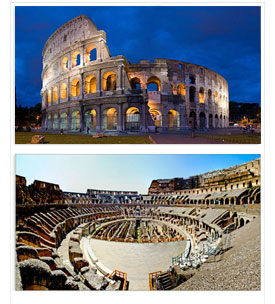







 |
|
||||||||||
 |
 |
|
|||||||||
|
|
|
||||||||||
|
|
|
|
|
||||||||
|
|
|
|
|||||||||
|
|
|||||||||||
|
|
 |
 |
|
||||||||
 |
|
||||||||||
|
|
|||||||||||
|
|
|||||||||||
|
|
|||||||||||
|
|
|
||||||||||
|
|
|||||||||||
|
|
|||||||||||
 |
|
||||||||||
 |
|
||||||||||
|
|
|
|
|
|
|
|
|
|
|
|
|

The Colosseum or Coliseum, originally the Flavian Amphitheatre (Latin: Amphitheatrum Flavium, Italian Anfiteatro Flavio or Colosseo), is an elliptical amphitheatre in the centre of the city of Rome, Italy, the largest ever built in the Roman Empire. It is one of the greatest works of Roman architecture and engineering.
Occupying a site just east of the Roman Forum, its construction started between 70 and 72 AD under the emperor Vespasian and was completed in 80 AD under Titus, with further modifications being made during Domitian's reign.
Originally capable of seating around 50,000 spectators, the Colosseum was used for gladiatorial contests and public spectacles. It remained in use for nearly 500 years with the last recorded games being held there as late as the 6th century – well after the traditional date of the fall of Rome in 476. As well as the traditional gladiatorial games, many other public spectacles were held there, such as mock sea battles, animal hunts, executions, re-enactments of famous battles, and dramas based on Classical mythology. The building eventually ceased to be used for entertainment in the early medieval era. It was later reused for such varied purposes as housing, workshops, quarters for a religious order, a fortress, a quarry and a Christian shrine.
Although it is now in a ruined condition due to damage caused by earthquakes and stone-robbers, the Colosseum has long been seen as an iconic symbol of Imperial Rome. Today it is one of modern Rome's most popular tourist attractions and still has close connections with the Roman Catholic Church, as each Good Friday the Pope leads a torchlit "Way of the Cross" procession to the amphitheatre.
Name
The Colosseum's name has long been believed to be derived from a colossal statue of Nero nearby.[1] This statue was later remodeled by Nero's successors into the likeness of Helios (Sol) or Apollo, the sun god, by adding the appropriate solar crown. Nero's head was also replaced several times and substituted with the heads of succeeding emperors. Despite its pagan links, the statue remained standing well into the medieval era and was credited with magical powers. It came to be seen as an iconic symbol of the permanence of Rome.
In the 8th century, the Venerable Bede (c. 672–735) wrote a famous epigram celebrating the symbolic significance of the statue: Quandiu stabit coliseus, stabit et Roma; quando cadit coliseus, cadet et Roma; quando cadet Roma, cadet et mundus ("as long as the Colossus stands, so shall Rome; when the Colossus falls, Rome shall fall; when Rome falls, so falls the world"). This is often mistranslated to refer to the Colosseum rather than the Colossus (as in, for instance, Byron's poem Childe Harold's Pilgrimage). However, at the time that Bede wrote, the masculine noun coliseus was applied to the statue rather than to what was still known as the Flavian amphitheatre.
The Colossus did eventually fall, probably being pulled down to reuse its bronze. By the year 1000 the name "Colosseum" (a neuter noun) had been coined to refer to the amphitheatre. The statue itself was largely forgotten and only its base survives, situated between the Colosseum and the nearby Temple of Venus and Roma.
The name was further corrupted to Coliseum during the Middle Ages. Both names are frequently used in modern English, but Flavian Amphitheatre is generally unknown. In Italy, the amphitheatre is still known as il colosseo, and other Romance languages have come to use similar forms such as le colisée (French), el coliseo (Spanish) and o coliseu (Portuguese).
For more information, click here.